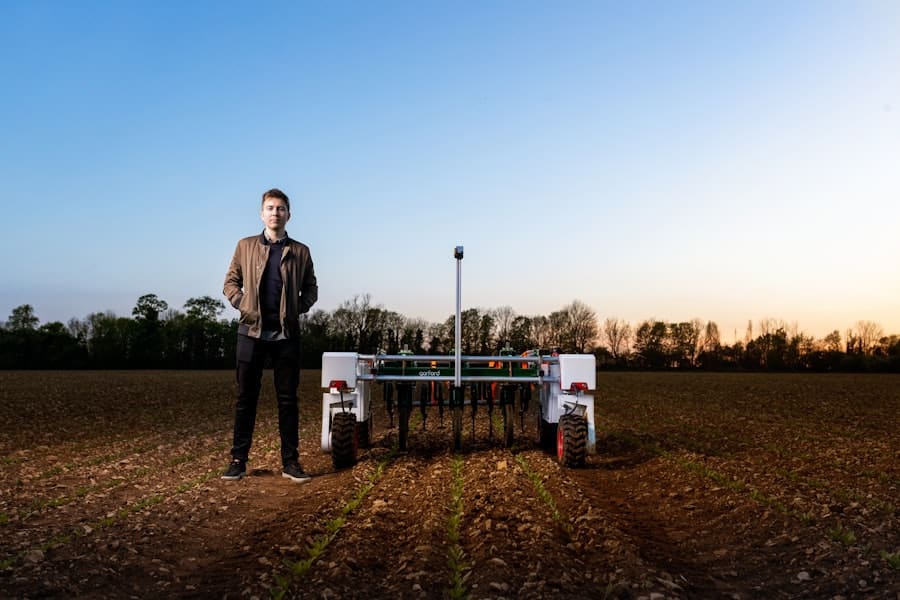The advent of 5G technology marks a significant leap in the evolution of mobile telecommunications, promising unprecedented speed, reduced latency, and enhanced connectivity. Unlike its predecessors, 5G is designed to support a vast array of devices and applications, making it a cornerstone for the Internet of Things (IoT). With theoretical download speeds reaching up to 10 Gbps and latency as low as one millisecond, 5G is not merely an incremental upgrade; it represents a paradigm shift in how data is transmitted and processed.
This technology operates on a new spectrum of frequencies, including millimeter waves, which allows for greater bandwidth and the ability to connect a multitude of devices simultaneously. The implications of 5G extend far beyond consumer electronics and telecommunications. Industries across the board are poised to benefit from its capabilities, particularly agriculture.
As the global population continues to rise, the demand for food production intensifies, necessitating innovative solutions to enhance efficiency and sustainability in farming practices. The integration of 5G technology into agricultural IoT systems can facilitate real-time data collection and analysis, enabling farmers to make informed decisions that optimize crop yields and resource management. This article delves into the potential of 5G in large-scale agricultural IoT, exploring its advantages, challenges, real-world applications, and future prospects.
Key Takeaways
- 5G technology is the next generation of mobile internet connectivity, offering faster speeds and more reliable connections than ever before.
- 5G has the potential to revolutionize large-scale agricultural IoT by enabling real-time data collection and analysis for improved decision-making.
- The advantages of 5G for agricultural IoT adoption include increased efficiency, enhanced precision farming, and better connectivity in remote areas.
- Challenges and limitations of 5G in agricultural IoT include high implementation costs, infrastructure requirements, and potential security concerns.
- Case studies of 5G implementation in agricultural IoT showcase successful use cases such as smart irrigation systems and livestock monitoring, demonstrating the technology’s potential in transforming agriculture.
The Potential for 5G in Large-Scale Agricultural IoT
The potential for 5G technology in large-scale agricultural IoT is immense, as it can transform traditional farming practices into smart, data-driven operations. By connecting various devices such as sensors, drones, and autonomous machinery through a robust 5G network, farmers can monitor their fields in real-time. This connectivity allows for the collection of vast amounts of data regarding soil conditions, weather patterns, crop health, and pest activity.
Such insights enable farmers to implement precision agriculture techniques, which can significantly enhance productivity while minimizing resource waste. Moreover, the low latency characteristic of 5G is particularly beneficial for applications requiring immediate feedback. For instance, autonomous tractors equipped with 5G connectivity can receive real-time data from sensors in the field, allowing them to adjust their operations dynamically.
This capability not only improves efficiency but also reduces the likelihood of human error. Furthermore, the ability to connect thousands of devices simultaneously means that farmers can deploy a comprehensive network of IoT devices without worrying about bandwidth limitations. This scalability is crucial for large agricultural operations that require extensive monitoring across vast areas.
Advantages of 5G for Agricultural IoT Adoption
One of the most significant advantages of 5G technology in agricultural IoT is its ability to facilitate real-time data transmission. This immediacy allows farmers to respond swiftly to changing conditions in their fields. For example, if a sensor detects a sudden drop in soil moisture levels, farmers can be alerted instantly and take action to irrigate the affected area before crop stress occurs.
This proactive approach not only enhances crop health but also conserves water resources by ensuring that irrigation is applied only when necessary. Additionally, 5G’s high-speed connectivity enables the use of advanced technologies such as artificial intelligence (AI) and machine learning (ML) in agriculture. These technologies can analyze large datasets collected from various sources to identify patterns and predict outcomes.
For instance, AI algorithms can process historical weather data alongside current soil conditions to forecast optimal planting times or predict pest outbreaks. By leveraging these insights, farmers can make data-driven decisions that lead to increased yields and reduced operational costs. Another advantage lies in the enhanced connectivity that 5G provides in rural areas where traditional broadband services may be lacking.
Many agricultural operations are located in remote regions where internet access is limited or unreliable. The deployment of 5G networks can bridge this digital divide, allowing farmers in these areas to access critical information and tools that were previously out of reach. This democratization of technology can empower smallholder farmers and contribute to more equitable agricultural practices.
Challenges and Limitations of 5G in Agricultural IoT
Despite its numerous advantages, the implementation of 5G technology in agricultural IoT is not without challenges. One significant hurdle is the infrastructure required to support 5G networks. The deployment of 5G involves substantial investment in new base stations and antennas capable of handling higher frequency signals.
In rural areas where many agricultural operations are located, the cost and logistics of building this infrastructure can be prohibitive. Additionally, regulatory hurdles and land-use policies may complicate the installation of necessary equipment. Another challenge is the interoperability of devices within the agricultural IoT ecosystem.
As various manufacturers produce sensors and equipment with different communication protocols, ensuring seamless integration can be complex. Farmers may face difficulties in managing a diverse array of devices that do not communicate effectively with one another. This fragmentation can hinder the full realization of 5G’s potential benefits unless industry standards are established to promote compatibility among devices.
With the proliferation of IoT devices collecting sensitive information about farming practices and crop yields, the risk of cyberattacks becomes a pressing issue. Farmers must be vigilant about securing their networks and protecting their data from unauthorized access or manipulation.
Addressing these challenges will be crucial for fostering trust in 5G-enabled agricultural IoT solutions.
Case Studies of 5G Implementation in Agricultural IoT
Several pioneering case studies illustrate the successful implementation of 5G technology in agricultural IoT settings. One notable example comes from China, where a large-scale smart farming project was launched in collaboration with telecommunications companies and agricultural research institutions. In this initiative, farmers utilized 5G-connected drones equipped with high-resolution cameras to monitor crop health across expansive fields.
The drones transmitted real-time images back to farmers, allowing them to identify areas requiring attention promptly. This approach not only improved crop management but also reduced labor costs associated with manual inspections. In Europe, a similar project was undertaken in Spain’s Andalusia region, where farmers adopted 5G technology to enhance irrigation practices.
By deploying soil moisture sensors connected via a 5G network, farmers could monitor moisture levels across their fields continuously. The system provided alerts when irrigation was needed, optimizing water usage and improving crop yields. This project demonstrated how 5G could facilitate sustainable farming practices while addressing water scarcity issues prevalent in many agricultural regions.
This initiative involved equipping tractors with 5G connectivity to enable real-time data sharing between machines and central management systems. Farmers could track equipment performance, monitor field conditions, and receive predictive analytics on crop health through a unified platform.
The results showed significant improvements in operational efficiency and resource management.
The Future of 5G in Large-Scale Agricultural IoT Adoption
Looking ahead, the future of 5G technology in large-scale agricultural IoT adoption appears promising but will require concerted efforts from various stakeholders. As more farmers recognize the benefits of connectivity and data-driven decision-making, demand for 5G-enabled solutions is likely to grow. Telecommunications companies will need to invest in expanding their networks into rural areas while ensuring that infrastructure development aligns with farmers’ needs.
Moreover, advancements in edge computing will play a crucial role in enhancing the capabilities of 5G in agriculture. By processing data closer to where it is generated—such as on-site sensors or drones—edge computing can reduce latency further and improve response times for critical applications like autonomous machinery or real-time monitoring systems. This synergy between 5G and edge computing will enable even more sophisticated applications that can revolutionize farming practices.
Collaboration among industry players will also be essential for driving innovation in this space. Agritech startups are emerging with novel solutions that leverage 5G technology for various applications, from precision farming to supply chain optimization. Partnerships between these startups, established agribusinesses, and telecommunications providers can foster an ecosystem conducive to rapid development and deployment of new technologies.
Considerations for Farmers and Agribusinesses
As farmers and agribusinesses contemplate adopting 5G technology within their operations, several considerations must be taken into account. First and foremost is the assessment of specific needs and objectives related to their farming practices. Understanding how 5G can address particular challenges—such as improving yield forecasting or enhancing resource management—will guide investment decisions.
Additionally, farmers should evaluate the cost-benefit ratio associated with implementing 5G solutions. While the potential for increased efficiency and productivity is significant, initial investments in infrastructure and technology may be substantial. Conducting thorough cost analyses and exploring available funding options or government incentives can help mitigate financial risks associated with transitioning to a connected agricultural model.
Training and education are also critical components for successful adoption. As new technologies are integrated into farming practices, ensuring that staff members are adequately trained to utilize these tools effectively will be vital for maximizing their benefits. Farmers should seek out resources and training programs that provide insights into best practices for leveraging 5G-enabled technologies.
The Role of 5G in Transforming Agriculture
The integration of 5G technology into large-scale agricultural IoT has the potential to revolutionize farming practices by enabling real-time data collection, enhancing connectivity among devices, and facilitating advanced analytics through AI and machine learning. While challenges such as infrastructure costs and data security concerns exist, successful case studies demonstrate that innovative solutions are already being implemented worldwide. As we look toward the future, it is clear that collaboration among stakeholders—farmers, agribusinesses, telecommunications providers, and technology developers—will be essential for unlocking the full potential of 5G in agriculture.
By embracing this transformative technology, the agricultural sector can not only meet the growing demands for food production but also do so sustainably and efficiently in an increasingly connected world.
A related article to The Impact of 5G on Large-Scale Agricultural IoT Adoption is “The Best Software for Social Media Content: A Comprehensive Guide.” This article provides valuable information on the top software tools available for creating engaging social media content. To learn more about enhancing your social media presence, check out this article.
FAQs
What is 5G?
5G is the fifth generation of wireless technology, offering faster speeds and more reliable connections on smartphones and other devices than ever before.
How does 5G impact large-scale agricultural IoT adoption?
5G can significantly impact large-scale agricultural IoT adoption by providing faster and more reliable connectivity for a wide range of IoT devices used in agriculture, such as sensors, drones, and autonomous machinery.
What are the benefits of 5G for agriculture?
Some benefits of 5G for agriculture include improved connectivity for IoT devices, enabling real-time data collection and analysis, enhanced precision farming techniques, and increased efficiency in agricultural operations.
How does 5G improve IoT connectivity in agriculture?
5G improves IoT connectivity in agriculture by offering faster data transfer speeds, lower latency, and the ability to connect a larger number of devices simultaneously, which is essential for large-scale agricultural IoT deployments.
What are some potential applications of 5G in agriculture?
Potential applications of 5G in agriculture include remote monitoring of crops and livestock, precision agriculture, autonomous farming machinery, and drone-based crop monitoring and spraying.
What are the challenges of implementing 5G in agriculture?
Challenges of implementing 5G in agriculture include the need for extensive network infrastructure, especially in rural areas, as well as the cost of upgrading existing IoT devices to be 5G-compatible.



